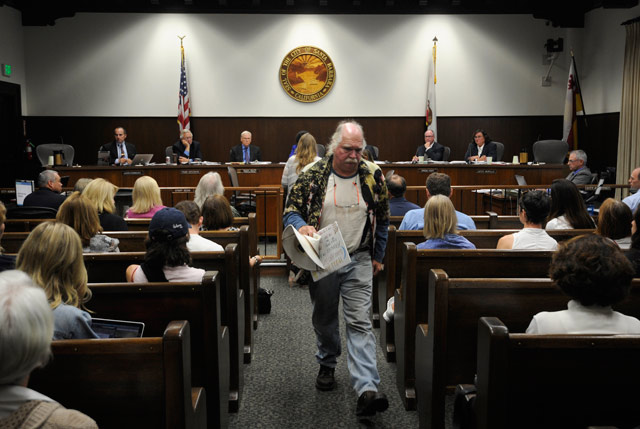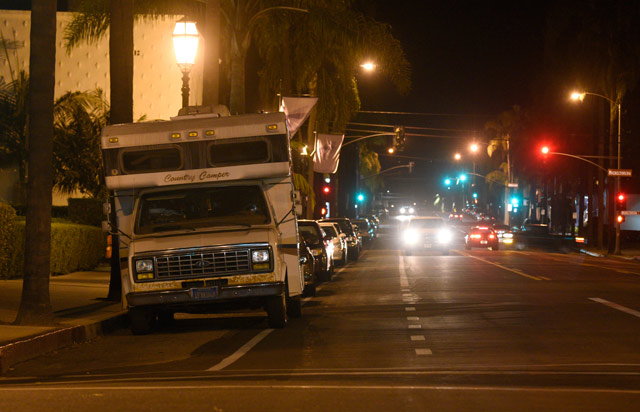Santa Barbara Bans RV Parking
Council Adopts Citywide Ban on RV Parking

After 15 years of attempting to regulate where RV dwellers can and cannot legally park, the Santa Barbara City Council voted unanimously to ban all RVs from parking on any city street. Likening past enforcement efforts to “whack-a-mole,” councilmembers adopted an entirely new legal approach based on vehicle size. This approach, they hope, will effectively inoculate them against all but certain lawsuits alleging bias and discrimination based on income and status. “We don’t really care about what’s going [on] inside the vehicle,” declared City Attorney Ariel Calonne. “What we care about is the mass of the vehicle.”
Under the new law, no mention is even made of RVs; instead, it refers to “Oversized Vehicles,” defined as anything longer than 25 feet, wider than 80 inches, or taller than 82 inches. City police say the presence of RVs in neighborhoods ranks as the number one “quality of life” complaint they receive. But the new law is strategically silent about the economic status of the occupants or their behavior. Instead, the issue is couched as traffic safety. City streets, built 90 years ago, are too narrow to accommodate wide-rumped vehicles without causing visibility and maneuverability issues for oncoming motorists, pedestrians, and cyclists.
For one hour, Calonne delivered a crash course detailing the past 15 years of enforcement frustration, including three lawsuits filed by Homes on Wheels on behalf of RV dwellers. He also outlined the growing impatience of the courts with municipal efforts to run the homeless out of town. Although many critics in the council chamber made it clear they thought his whole strategy was a ruse to disguise just that, Calonne pointed out that City Hall has spent $46 million on various programs to help the homeless since 1991. “The image of wealthy Santa Barbara putting the jackboot of authority on the necks of the homeless sells papers,” he said, but was at odds with objective reality. For example, he noted how the New Beginnings Safe Parking Program currently provides nighttime parking spaces for 115 four-wheeled “homes” throughout the South Coast.

The program emerged out of one of the many lawsuits brought by Homes on Wheels. Kristine Schwartz, who runs that program now, asked the council to help her figure out “what to tell our clients [about] where they should park during the day.” Schwartz predicted that the new law will result in a lot more tickets that won’t be paid. When the vehicles are towed, the occupants, she said, would wind up on the streets or worse.
Many speakers testified the new ordinance was necessary to make the roads safer. Others demanded any evidence linking traffic collisions to the presence of RVs on city streets, prompting one ordinance supporter to demand, “Do we have to have someone die to say there’s a safety risk?”
Councilmember Cathy Murillo sought to soften the effect of the new ordinance by demanding greater funding so the Safe Parking Program could be expanded: “These regulations will make life difficult for people who already have very difficult lives.” No vote on additional funding was forthcoming, but the council did support the creation of an ad hoc subcommittee to explore ways to expand off-street parking options for people living in their vehicles.
Deborah Barnes, a longtime homeless service activist working to stop the ordinance, lamented the criminalization of the homeless, prompting Calonne to object, “We’re not criminalizing anything. This is a parking ticket.” The new ordinance will go into effect when 323 street signs, costing $75,000, are posted throughout the city. City Hall also has to adopt procedures for issuing temporary permits for oversized vehicles, with a limit of no more than 10 days out of every 90 days. Lastly, Calonne outlined a new process by which individuals with handicapped placards can apply for city permits to determine whether an oversized vehicle had been properly modified. This provision elicited heated opposition from Peter Marin, a homeless rights advocate for nearly 40 years, who vowed to sue the city. “You’re pushing it here,” said Marin. “You’re really pushing it.”
Editor’s Note: This story was revised to reflect that it is one of the three criteria — longer than 25 feet, wider than 80 inches, or taller than 82 inches — not all three, that defines an oversize vehicle.



